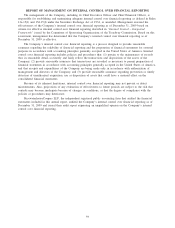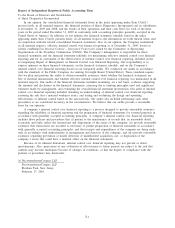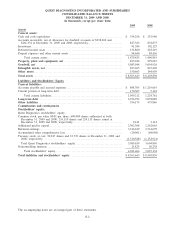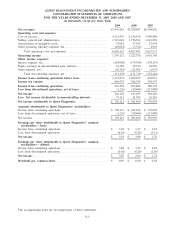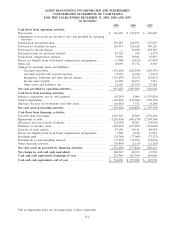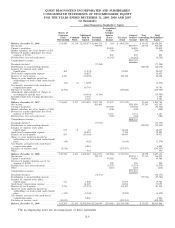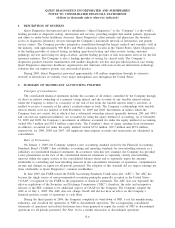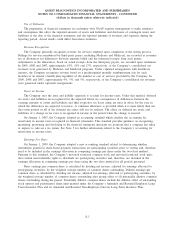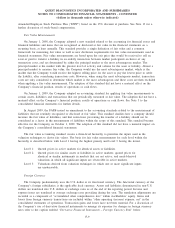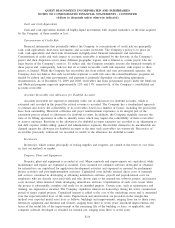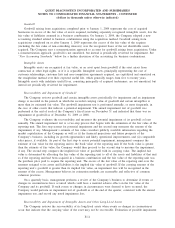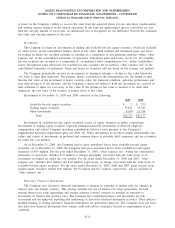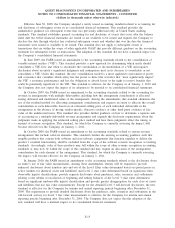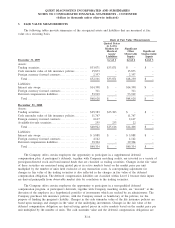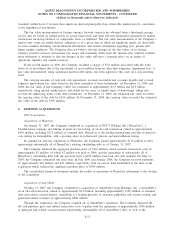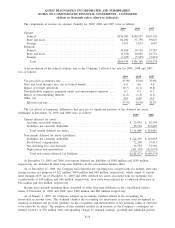Quest Diagnostics 2009 Annual Report Download - page 79
Download and view the complete annual report
Please find page 79 of the 2009 Quest Diagnostics annual report below. You can navigate through the pages in the report by either clicking on the pages listed below, or by using the keyword search tool below to find specific information within the annual report.Amended Employee Stock Purchase Plan (“ESPP”) based on the 15% discount at purchase. See Note 13 for a
further discussion of stock-based compensation.
Fair Value Measurements
On January 1, 2008, the Company adopted a new standard related to the accounting for financial assets and
financial liabilities and items that are recognized or disclosed at fair value in the financial statements on a
recurring basis, at least annually. This standard provides a single definition of fair value and a common
framework for measuring fair value as well as new disclosure requirements for fair value measurements used in
financial statements. Fair value measurements are based upon the exit price that would be received to sell an
asset or paid to transfer a liability in an orderly transaction between market participants exclusive of any
transaction costs, and are determined by either the principal market or the most advantageous market. The
principal market is the market with the greatest level of activity and volume for the asset or liability. Absent a
principal market to measure fair value, the Company would use the most advantageous market, which is the
market that the Company would receive the highest selling price for the asset or pay the lowest price to settle
the liability, after considering transaction costs. However, when using the most advantageous market, transaction
costs are only considered to determine which market is the most advantageous and these costs are then excluded
when applying a fair value measurement. The adoption of this standard did not have a material effect on the
Company’s financial position, results of operations or cash flows.
On January 1, 2009, the Company adopted an accounting standard for applying fair value measurements to
certain assets, liabilities and transactions that are periodically measured at fair value. The adoption did not have a
material effect on the Company’s financial position, results of operations or cash flows. See Note 3 to the
consolidated financial statements for further details.
In August 2009, the FASB issued an amendment to the accounting standards related to the measurement of
liabilities that are routinely recognized or disclosed at fair value. This standard clarifies how a company should
measure the fair value of liabilities, and that restrictions preventing the transfer of a liability should not be
considered as a factor in the measurement of liabilities within the scope of this standard. This standard became
effective for the Company on October 1, 2009. The adoption of this standard did not have a material impact on
the Company’s consolidated financial statements.
The fair value accounting standard creates a three-level hierarchy to prioritize the inputs used in the
valuation techniques to derive fair values. The basis for fair value measurements for each level within the
hierarchy is described below with Level 1 having the highest priority and Level 3 having the lowest.
Level 1: Quoted prices in active markets for identical assets or liabilities.
Level 2: Quoted prices for similar assets or liabilities in active markets; quoted prices for
identical or similar instruments in markets that are not active; and model-derived
valuations in which all significant inputs are observable in active markets.
Level 3: Valuations derived from valuation techniques in which one or more significant inputs
are unobservable.
Foreign Currency
The Company predominately uses the U.S. dollar as its functional currency. The functional currency of the
Company’s foreign subsidiaries is the applicable local currency. Assets and liabilities denominated in non-U.S.
dollars are translated into U.S. dollars at exchange rates as of the end of the reporting period. Income and
expense items are translated at average exchange rates prevailing during the year. The translation adjustments are
recorded as a component of “accumulated other comprehensive loss” within stockholders’ equity. Gains and
losses from foreign currency transactions are included within “other operating (income) expense, net” in the
consolidated statements of operations. Transaction gains and losses have not been material. For a discussion of
the Company’s use of derivative financial instruments to manage its exposure for changes in foreign currency
rates refer to the caption entitled “Derivative Financial Instruments – Foreign Currency Risk” below.
F-9
QUEST DIAGNOSTICS INCORPORATED AND SUBSIDIARIES
NOTES TO CONSOLIDATED FINANCIAL STATEMENTS - CONTINUED
(dollars in thousands unless otherwise indicated)


